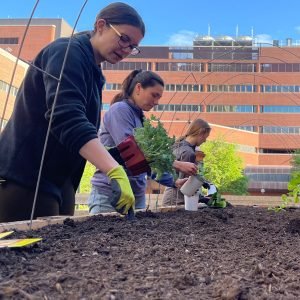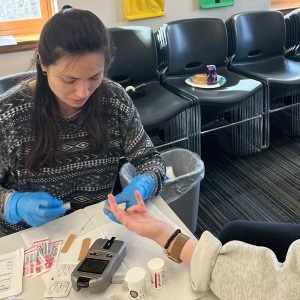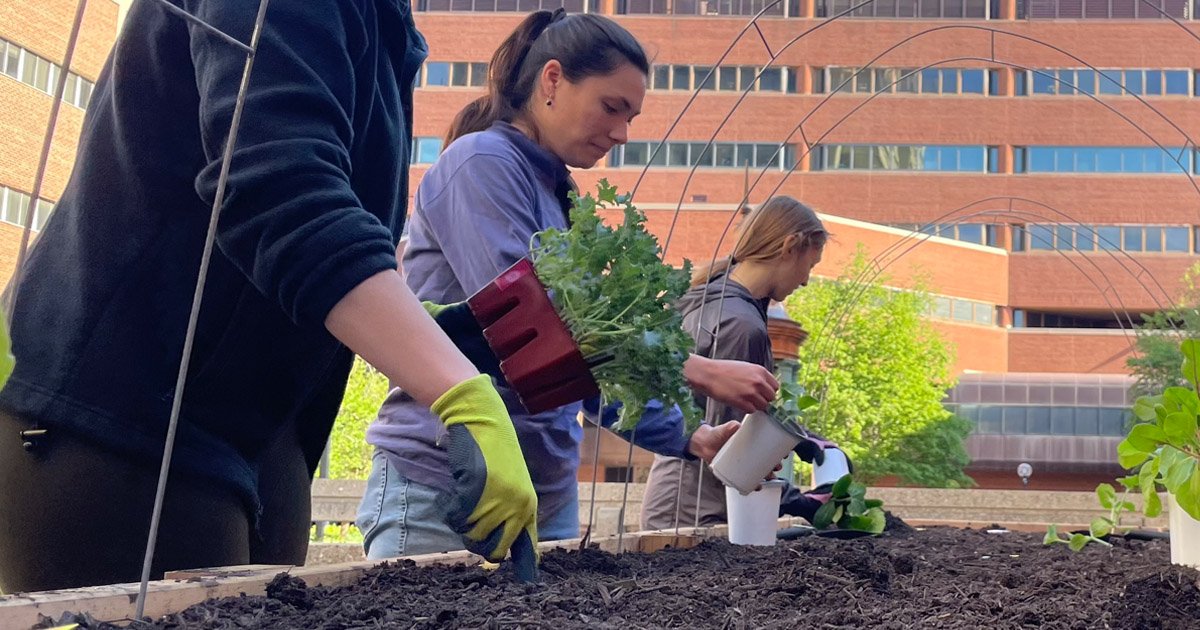"Not everyone in the U.S. has easy access to healthy foods. It’s a very broad problem with lots of variables which means there are many different ways public health can address and improve food access and food insecurity issues."
First, I’d like to know a little bit about you as a person. Where did you grow up? Where did you attend undergrad and what was your degree/area of study? [Rita] I grew up in Vermont and I went to the University of Washington in Seattle for my undergrad degree, which was in socio-cultural anthropology. I pretty quickly discovered my interest in food systems during undergrad and almost minored in nutrition.
What drew you to public health?[Rita] After college, I worked on a small diversified farm (with both crops and animals) in Maine. Then, I got a job at the UMaine Cooperative Extension teaching nutrition education to families and children. At the Cooperative Extension I worked with a lot of different community partners and also was working with some registered dietitians (RD), which eventually led to me applying to the Public Health Nutrition, Coordinated Program, which will allow me to eventually become an RD myself. At the time, I didn’t realize that the work I was doing was in public health, but I quickly realized this when I started at SPH.
What specific issue, problem, or area of research in public health do you care the most about and why? [Rita] In general, an overarching interest of mine is expanding access to healthy food. Not everyone in the U.S. has easy access to healthy foods. It’s a very broad problem with lots of variables which means there are many different ways public health can address and improve food access and food insecurity issues.
 Can you tell me about the Interprofessional (IP) Student Garden? [Rita] The garden was started within the beWell program and the Center for Health Interprofessional Programs (CHIP). In 2020, health sciences students were surveyed about what kinds of programming would contribute to student health and wellbeing and one thing that was mentioned was gardening. A lot of work from staff and previous students went into making it possible to create the IP Student Garden and in May of 2022 a group of students, staff, and community members built the raised beds and started planting. The garden is run by a board made up of health sciences students and staff and we host weekly events (Plant & Chats) where students can come and join us to do activities around the garden and meet other students. The project is still getting off the ground but we’ve definitely talked about different ways to provide students with produce from the garden. Right now, we have small signs placed in the garden saying “I’m ready!”, letting anyone who walks by the garden know which produce they can harvest for themselves.
Can you tell me about the Interprofessional (IP) Student Garden? [Rita] The garden was started within the beWell program and the Center for Health Interprofessional Programs (CHIP). In 2020, health sciences students were surveyed about what kinds of programming would contribute to student health and wellbeing and one thing that was mentioned was gardening. A lot of work from staff and previous students went into making it possible to create the IP Student Garden and in May of 2022 a group of students, staff, and community members built the raised beds and started planting. The garden is run by a board made up of health sciences students and staff and we host weekly events (Plant & Chats) where students can come and join us to do activities around the garden and meet other students. The project is still getting off the ground but we’ve definitely talked about different ways to provide students with produce from the garden. Right now, we have small signs placed in the garden saying “I’m ready!”, letting anyone who walks by the garden know which produce they can harvest for themselves.
Are you currently involved in any public health research or professional work?
[Rita] I’m a part of the Maternal and Child Health Nutrition Traineeship at SPH, which I’ve been doing since I started grad school. My first year I worked with Midwest Food Connection which is an organization that does food education in schools. One project I worked on with them was creating tasting kits that kids could take home to their family members to engage parents in the food education kids were receiving at school. This year, another student and I were approved for a graduate student grant through the Healthy Food Healthy Lives Institute. For this project, we’ve been talking with low income families about their home gardening practices and what resources they currently use and what resources would support them further in gardening. Our goal is to come up with a set of recommendations on how UMN Extension could make their resources more accessible to low income families.
Why did you choose to come to the U of M School of Public Health? [Rita] I chose to come to U of M because The Public Health Nutrition program with the coordinated track is very unique because it combines the coursework to receive an MPH with the course work and internship hours to sit the registered dietitian (RD) exam. One thing I have really appreciated about the program is the many opportunities for hands-on public health work through internships and other community engagement opportunities. When I attended Admitted Student Day, I really liked what current students were sharing in the info sessions and also the questions admitted students were asking. Based on what people were saying and doing, it felt like SPH was an environment that would work well for me, and so far it has.
 What are the reasons why you chose your program? What do you like about it?
What are the reasons why you chose your program? What do you like about it?
[Rita] My favorite part about the program has been the internships and opportunities outside of the classroom such as volunteering in the Phillips Neighborhood Clinic and the variety of internships I’ve done (from WIC to school food service). That’s been one of the best parts, along with the huge amount of support and encouragement from my professors and peers.
What has been your favorite class so far?
[Rita] I think the two classes that went really well together were Eval 1 (PubH 6034) with Professor Traci Toomey and Community Nutrition Interventions (PubH 6914) with Associate Professor Jennifer Linde. I learned really complimentary skills from those courses by taking them at the same time. How nutrition interventions work is one of the things that I’m interested in and I also liked evaluation because that was focused on how to improve public health programs.
What do you like about being in Minnesota? [Rita] I really like that it’s so easy to get outside. I like spending time outdoors in both the winter and in the summer. I like that it’s easy to get outside the city and experience nature.

